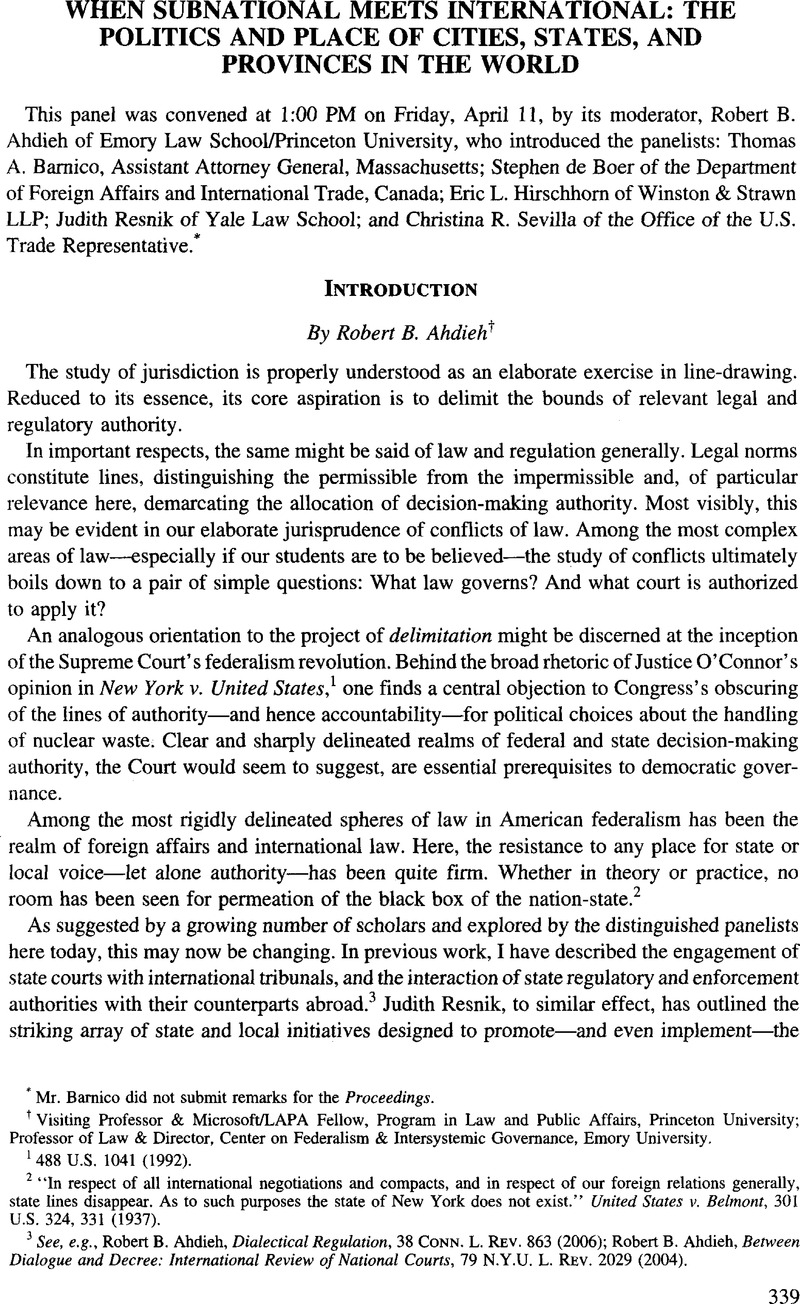No CrossRef data available.
Article contents
Introduction
Published online by Cambridge University Press: 28 February 2017
Abstract

- Type
- When Subnational Meets International: The Politics and Place of Cities, States, and Provinces in the World
- Information
- Copyright
- Copyright © American Society of International Law 2008
References
* Mr. Barnico did not submit remarks for the Proceedings.
1 488 U.S. 1041 (1992).
2 “In respect of all international negotiations and compacts, and in respect of our foreign relations generally, state lines disappear. As to such purposes the state of New York does not exist.” United States v. Belmont, 301 U.S. 324, 331 (1937).
3 See, e.g., Ahdieh, Robert B. Dialectical Regulation, 38 Conn. L. Rev. 863 (2006)Google Scholar; Ahdieh, Robert B. Between Dialogue and Decree: International Review of National Courts, 79 N.Y.U. L. Rev. 2029 (2004)Google Scholar.
4 See Resnik, Judith, Foreign as Domestic Affairs: Rethinking Horizontal Federalism and Foreign Affairs Preemption in Light of Translocal Internationalism, 57 Emory L. J. 31 (2007)Google Scholar.
5 Mr. Hirschhorn served as counsel to the NFTC in National Foreign Trade Council v. Giannoulias, 523 F. Supp. 2d 731 (N.D. 111. 2007), and Mr. Barnico served as counsel to Massachusetts in Crosby v. National Foreign Trade Council, 530 U.S. 363 (2000).
6 See Resnik, Judith, Law ‘s Migration: American Exceptionalism, Silent Dialogues, and Federalism ‘s Multiple Points of Entry, 115 Yale L. J. 1564 (2006)CrossRefGoogle Scholar.
7 See Resnik, supra note 4.
8 I have previously explored such patterns of engagement across jurisdictional lines, under the rubric of “intersys-temic governance.” in such circumstances, I suggest, we may find
a regulatory regime characterized by increased interaction, of a more recurrent nature, and by a close intermingling of regulatory conflict and cooperation. Ultimately, rather than increased regulatory coordination supporting each [jurisdiction’s] pursuit of its own [goals], we may see something akin to joint, or intertwined, regulation of relevant individuals, institutions, or subject-matter. in such regimes, discrete sets of regulatory rules may collapse into a collective whole.
Ahdieh, supra note 3, at 865 (internal citations omitted). Such regimes exhibit a distinct set of institutional characteristics, including (1) a heightened embrace of complexity, as compared to a single-minded emphasis on clarity; (2) a potential for the operational interdependence of regulatory institutions across jurisdictional lines, and (3) a central role for persuasion, rather than coercion, in determining the efficacy of relevant law and regulation. See Ahdieh, Robert B. From Federalism to Intersystemic Governance: The Changing Nature of Modern Jurisdiction, 57 Emory L. J. 1 (2007)Google Scholar. Further, they offer a counterpoint to conventional normative critiques of jurisdictional overlap and regulatory complexity, by exhibiting a heightened capacity to overcome regulatory inertia, to foster innovation, and to facilitate salutary integration. See Ahdieh, supra note 3, at 879-96.
9 I explore and develop this “coordination” account of the relationship of international, national, and subnational institutions and interests in a forthcoming work. See Ahdieh, Robert B. Foreign Affairs, International Law, and the New Federalism: Lessons from Coordination, 73 Mo. L. Rev. 1185 (2008)Google Scholar.
10 United States v. Belmont, 301 U.S. 324, 331 (1937).
11 See Ahdieh, supra note 9 (describing State of Illinois’ Sudanese divestment legislation, and Supreme Court’s decision in Medellin v. Texas, 128 S. Ct. 1346 (2008), which left compliance with International Court of Justice’s Avena decision to the State of Texas).


